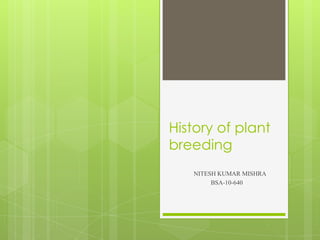
Pbg 301
- 1. History of plant breeding NITESH KUMAR MISHRA BSA-10-640
- 2. Different definitions of plant breeding 1. Vavilov (1935) – plant breeding is the evolution directed by the will of man 2. Stebbins (1957) – plant breeding is merely a continuation of the natural evolution of crop plant species, changing its course in the direction of greater use to mankind. 3. Riley – plant breeding is a technology of the production of varieties of crop plants adapted to man’s needs. 4. Frankel – plant breeding is the adjustment of plants to the service of mankind. 5. Poehlman & sleeper- plant breeding is the art and science of improving the heredity of plants for the benefit of human.
- 3. Babylonians and Assyrians pollinated date palm artificially as early as 700 B.C. Assyria and babylonia is what we call as the modern day Iraq. Iraq being the desert area so the palm cultivation was more hence the people first began artificial pollination in date palms those days. Thomas Fairchild (1717) produced the first artificial hybrid. Thomas Fairchild was the first English nurseryman to experiment with hybridization of plants. Before 1717 he placed the pollen of sweet william on the style of carnations. Johnson (1829) states that he was one of the few gardeners "uniting a love of science with the practice of his art.“ He was the author of The City Gardener (1722) which was the first book on town gardening.
- 4. Knight was the first man to use artificial hybridization to develop several new fruit varieties. Le Couteur and Shireff used individual plant selection and progeny test to develop some useful cereal varieties. FATHER OF GENETICS - GREGOR JOHAN MENDEL FATHER OF MODERN GENETICS – THOMAS HUNT MORGAN
- 5. Joseph kolreuter Josef Gottlieb Kölreuter, German botanist who was a pioneer in the study of plant hybrids.. Cultivating plants with the purpose of studying their fertilization and development, he performed experiments, particularly with the tobacco plant (Nicotiana), that included artificial fertilization and the production of fertile hybrids between plants of different species. The experimental results he obtained foreshadowed the work of the Austrian biologist Gregor Johann Mendel.
- 7. CHRONOLOGY OF PLANT BREEDING 1890- Rimpu in sweden made ist intergeneric cross between bread wheat and Rye. 1900- Devries , Correns , and Tschermark independently rediscovered Mendel’s laws of inheritance. 1903- johanssen coined the terms : 1. genotype 2. phenotype 3. pureline
- 8. 1908- Shull and East independently proposed over dominance heterosis in maize. 1908- Davenport first proposed dominance hypothesis of heterosis 1910- Bruce, Keeble and pellew elaborated dominance hypothesis proposed by Davenport. 1914- shull first used the term heterosis for hybrid vigour. 1917- Jones proposed dominance of linked gene hypothesis 1921- Sewall and Wright described systems of mating. 1926- East and Mangelsdorf ist discovered gametophytic system of self incompatibility in Nicotiana sanderae
- 9. 1927- Karpencheko developed first intergeneric hybrid between Raish and cabbage in Russia 1928- Stadler first used X-rays for induction of mutations in crop plants. 1935- Nagahern proposed the origin of tetraploid species of Brassica using a triangle. 1937-Harrington proposed mass pedigree method of breeding. 1939- Gouldon first suggested the use of single seed descent in autogamous species. 1940-Jenkins described the procedure of recurrent selection.
- 10. 1945- Hull coined the term recurrent selection and over dominance working with Maize. 1952- Jensen first suggested the use of multilines in oats . 1953- Borlaug first outlined the method of developing multilines in Wheat. 1964- Borlaug developed high yielding semidwarf varieties of wheat which resulted in green revolution. 1965- Graphius first applied single seed descent method in Oats. 1970- C.T. patel first developed cotton hybrid for commercial cultivation in India.
- 11. 1983- Development of first transgenic plant in Tobacco in USA 1987- development of first transgenic plant by monsanto company in USA 1991- Release of world’s first pigeon pea hybrid (ICPRS) by ICRISAT for commercial cultivation in India. (GMS based) 1997- identification of terminator gene which allows germination of seed only for one germination by Monsanto.
- 12. INSTITUTIONAL DEVELOPMENT 1871- Department of Agriculture was created by GOI . 1892-first scientist appointed in the Dpartment , he was agricultural chemist. 1905- IARI- Imperial agricultural Research Institute. Pusa ( Bihar). 1929- Imperial Council of Agricultural Research was established. 1906- Agricultural college was started in coimbatore. Actually it was shifted from Saidapet in chennai. 1946-Present name of ICAR was christened. 1960- First agricultural university was started at Pantnagar. 1971- one of the pioneer centre for research in india TNAU was established.
- 13. references Plant breeding – phundan singh www.tnau.ac.in www.Gbpuat.ac.in
